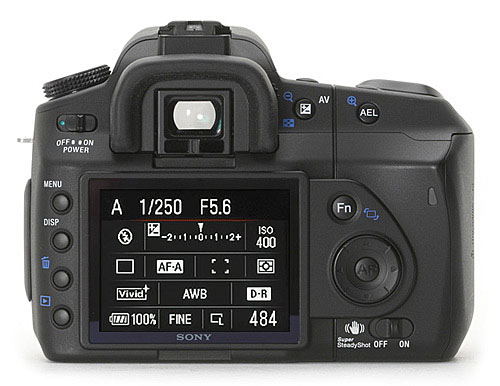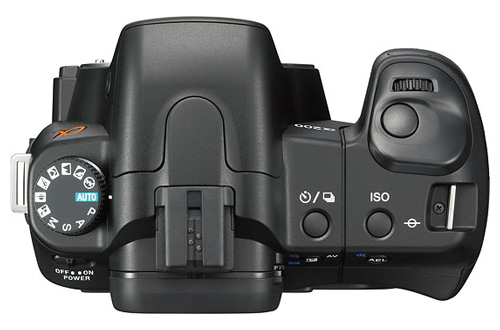Sony A200: Entry DSLR Roundup
by Wesley Fink on October 20, 2008 1:00 AM EST- Posted in
- Digital Camera
New Features, Improvements, and Omissions
The Sony A200 certainly epitomizes the fast pace of innovation in the DSLR market. When the Sony A100 was introduced it was the first of the 10MP DSLR cameras, and it was considered a breakthrough value at a price of just $999 with a kit lens. Now, just two years later the Sony A200 generally updates the A100 and cuts the price in half.
| Sony Camera Comparison | ||
| Sony A200 | Sony A100 | |
| LCD Screen | 2.7" Fixed | 2.5" Fixed |
| Sensor | 10.2 MP CCD | 10.2 MP CCD |
| AF Points | 9 | 9 |
| Sensor Size | 23.6x15.8mm | 23.6x15.8mm |
| Sensor Multiplier | 1.5x | 1.5x |
| Image Processor | BIONZ | BIONZ |
| Image Stabilization | Body Integral (All lenses) | Body Integral (All lenses) |
| Auto Sensor Clean | Yes | Yes |
| Live View | None | None |
| Metering Modes | Multi-Segment, CWt, Spot | Multi-Segment, CWt, Spot |
| ISO Range | 100-3200 | 100-1600 |
| Auto ISO Adjust | Yes | Yes |
| Continuous Speed | 3 fps | 3 fps |
| Wireless Flash Control with Built-in Flash | Yes | Yes |
| Remote Release | Wireless Remote, Cable | Wireless Remote, Cable |
| Storage | CF | CF |
| Viewfinder | .83x, 95% | .83x, 95% |
| Battery | NP-FM500H 1600mAh | NP-FM500H 1680mAh |
| Battery Life (50% Flash) | 750 | 730 |
| Battery Grip | VG-B30AM, Optional | No |
| Size | 131x98.5x71mm | 133x95x71mm |
| Weight (with Battery) | 1.39 lb. (626g) | 1.4 lb. (638g) |
| Kit Lens | 18-70mm f3.5-5.6 (28-105mm) | 18-70mm f3.5-5.6 (28-105mm) |
| Price with Kit Lens | $499 | $999 |
Normally a 50% price cut on a new model means reducing features. However, the A200 generally retains the same features as the well-regarded A100 while improving the camera in several areas. The LCD is now 2.7", up from 2.5" in the A100. While the sensor is the same resolution as the A100, the 10.2MP sensor now supports ISO 3200, up from the ISO1600 max of the A100. High ISO noise reduction is now adjustable on the A200.



Sony adds a 16:9 HDTV shooting mode to the A200, and image quality adjustments - contrast, saturation, sharpness - have wider adjustment ranges on the A200 than the A100. Super Steady Shot is also said to be improved on the A200. The only major omission sacrificed to the price reduction appears to be the depth-of-field preview button now absent on the A200.

The Sony A100 was criticized by many for not offering a battery grip option for extended battery life and better portrait handling. The A200 corrects that by supporting the Sony VG-B30AM battery grip that is also compatible with the Sony A300 and A350.
Sony has also continued some features you certainly don't expect to find in an entry-level DSLR. Most significant of these is the continued support for Wireless Flash capabilities that can be controlled by the built-in flash on the A200. Another is the 9-point AF module, which stands out in a class where some competitors try to get by with 3-point AF. The Sony A200 also continues real spot metering and adjustable bracketing, which are features some competitors have dropped to differentiate their higher-cost models.










32 Comments
View All Comments
deathwalker - Wednesday, October 22, 2008 - link
Broadway Photo has the A200 kit for $321..great deal.strikeback03 - Wednesday, October 22, 2008 - link
http://www.resellerratings.com/store/Broadway_Phot...">http://www.resellerratings.com/store/Broadway_Phot...good luck with that. Here is what they look like:
http://donwiss.com/pictures/BrooklynStores/h0006.h...">http://donwiss.com/pictures/BrooklynStores/h0006.h...
and
http://donwiss.com/pictures/BrooklynStores/h0049.h...">http://donwiss.com/pictures/BrooklynStores/h0049.h...
AkumaX - Friday, October 24, 2008 - link
It's hard to decide which camera to go for the coveted Entry Level DSLR position. Plenty of friends consider Canon or Nikon as the major players, and own either one.Having the opportunity to pick up the A200K for $413 shipped/no tax from SonyRewards last June helped factor in that decision. As a person who had zero experience or knowledge of the SLR domain, this was quite a gamble.
So for the past 4 months, haven taken over 8000 pictures (in RAW), and been to 2 foreign countries, this was definitely worth the investment. The biggest thing Sony has going for them is the backwards compatibility of the Minolta AF lens line.
I picked up a 50mm f/1.7 + 70-210mm f/4 (the "beercan") off CraigsList, since these seem to be "the" lenses to get. Having researched throughout these past few months about aperture, ISO, crop factor, etc... I'll probably pick up a 28mm f/2.8 also.
All in all, the Sony A200K offers a lot: 18-70mm kit lens - bigger than the rest, Minolta AF (Maxxum) Lens backwards compatibility, and plenty of alpha-based accessories. This one seems like a winner.
What am I doing? --> blog.anandtech.com/manthisiswhathappenswhenyoucantsleepandramble
cafmike1 - Monday, April 19, 2010 - link
I am waiting on the replacement SLR for the Nikon D90 herehttp://www.cameta.com/Nikon-D90-Digital-SLR-Camera...
Does anyone know when this thing is going to be announced?
Wineohe - Tuesday, October 21, 2008 - link
Hmm. I'm more critical of the ISO performance of the Sony A200. It just doesn't seem that good above 800. The Nikon and Olympus are decent and the Canon is affected by some softness and chromatic aberrations at all ISO settings, something that I attribute to it's junk lens. Given a better lens it would probably show it's stuff, but this is a budget comparison and that would be unfair. I wish Canon would spend even $3 more on making their cheapo 18-55.In general all of these camera packages boarder on being just too much of a compromise. However as I mentioned above the Olympus and the Nikon come close to being acceptable. Frankly I really don't care how many features the camera has if the output is just mediocre. An adequately equipped body with a step up lens is far better advise.
Heidfirst - Wednesday, October 22, 2008 - link
shoot RAW & pp. Sony's jpeg engine isn't the greatest.strikeback03 - Thursday, October 23, 2008 - link
I'd agree for higher level bodies, but the distinction probably isn't relevant for most consumers at the $500 price point.Wesley Fink - Wednesday, October 22, 2008 - link
The Canon lens used for testing was their excellent 50mm f1.4, so you can't blame the results on a cheapo lens. All of the tests used 50mm f1.4 primes execpt the Olympus where a 35mm macro was used because of the 2x lens factor. ALL these lenses are in the best part of their resolution curves at f/4, which was a requirement.Snapshots and regular images published in our reviews do use the kit lens, but not our noise tests.
Wineohe - Wednesday, October 22, 2008 - link
Oooh, my bad, I missed that. I actually have a 50mm f1.4 that I use occasionally on my 5D. It struggles in low light but otherwise is a fine lens. I was convinced the characteristics were that of poor optic since they seem to exist at low or high gain. Now I'm left scratching my embarrassed head. So much for the XS, it is getting long in the tooth.haplo602 - Tuesday, October 21, 2008 - link
I think you are using a few features in the A200 that are not even used by the buyers in this price range.wireless flash ... I mean come on ... what is the lowest priced Sony external flash that will work with this ? I found the HVL-F42AM as the lowest level model for about 1/2 the price of the A200 kit. No entry level DSRL user will shell out that much money for external flash, they will buy a better body in the first place.
generaly the people getting into this class DSLRs come from the P&S user group. They will still compose mostly with live view, so number of AF points is irelevant. Anyway what's the performance of the 9 focus points ? Only center one is a cross sensor ? Then the other ones will be a source of frustration for the P&S crowd in most conditions :-)